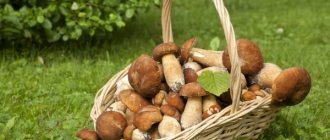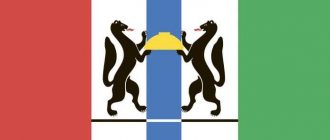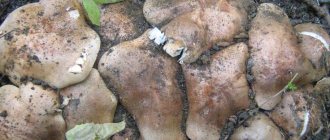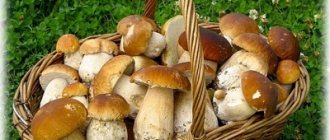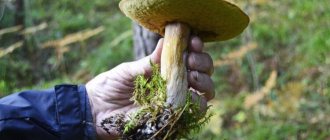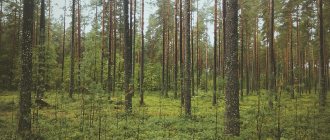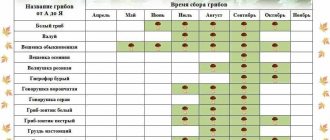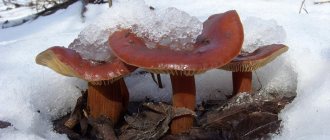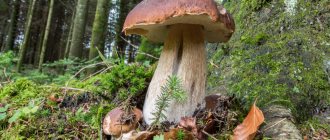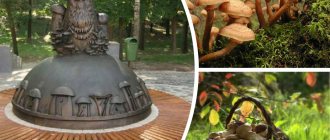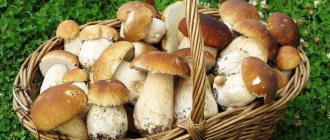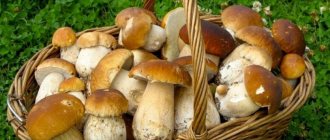The Voronezh region is rich in edible mushrooms, of which there are about 200 different species. Many mushrooms are a source of various vitamins and minerals and are also rich in carbohydrates and proteins. In addition to beneficial mushrooms, on the territory of Voronezh you can often stumble upon conditionally edible and poisonous species of mushrooms. Conditionally edible fruits should be included in the diet only after heat treatment. And poisonous ones can cause irreparable harm to health and even lead to death. Let's look at which mushrooms from the Voronezh region are healthy and which ones should be avoided.
Edible
Of the edible mushrooms growing in the region, the predominant ones are chanterelles, honey mushrooms, boletus, porcini, boletus, row, boletus, boletus and russula. Here we propose to consider these species separately, learn more about their properties and favorite habitats.
Chanterelle
Chanterelles
Common chanterelle bears fruit from early June to October and can grow on forest litter, moss, and grass. It is found both in coniferous and mixed forests, but they especially love the proximity to pine, spruce, beech, and oak.
The fruiting body is extremely rarely touched by worms. It's all about the quinomannose they contain - a substance that is harmless to humans, but fatal to arthropods, worms and slugs.
Like many other species, the chanterelle has a poisonous counterpart, the false chanterelle, so care and experience are required when collecting these mushrooms.
Honey mushrooms
Honey mushrooms
Elastic, aromatic mushrooms that delight us with their harvests almost all year round. Types of honey mushrooms differ in time and place of growth. So, real or autumn ones are considered the most delicious. They can be found both on stumps and living trees (usually birches) in late summer - early autumn.
Summer honey mushrooms are also found, the fruiting period is from late May to late autumn. Summer ones are not so tasty and are usually eaten boiled.
Winter representatives can be found during thaws on old poplars and willows. Their taste is neutral (essentially none), complemented by a light mushroom aroma, but nevertheless, these mushrooms are quite tasty when pickled and salted.
Expert opinion
Melnikov Vladimir Mikhailovich
Knows 1000 ways to cook, pickle and marinate any types of mushrooms
It is impossible not to mention meadow honey mushrooms. These, as one would expect from the name, grow in meadows and clearings. They can be found from May until approximately the end of summer. They have a pleasant, slightly sweet taste and can be eaten either boiled or fried, or pickled.
Real oil can
Butter
Quite tasty mushrooms with an oily shiny cap, which is why they got their name. There are more than 50 varieties of boletus, and the collection season, depending on the specific species, stretches from early summer to late autumn.
White mushrooms
The mushroom got its name from the color of the pulp, which remains white even after drying or heat treatment. These mushrooms are rightfully considered one of the most delicious and valuable. The fruiting season of whites is from June to August, and the favorite habitat is mixed forests.
Porcini
Ryadovka
Rows
There are more than a hundred varieties of row mushrooms, ranging from edible and conditionally edible to inedible and downright poisonous. This is such a family rich in varieties. The collection of rows begins in May and can continue (depending on the species) until autumn.
Red boletus
Boletus
Another quite tasty and valuable mushroom, growing both in coniferous and deciduous, and in mixed forests, in clearings and on the edges. It is quite difficult to confuse the boletus with any other mushroom - its red to brown cap and memorable stem will not allow you to do this. The boletus collection season is quite long - starting in May, it can last until mid-October.
Expert opinion
Melnikov Vladimir Mikhailovich
Knows 1000 ways to cook, pickle and marinate any types of mushrooms
Boletus is good both fried and boiled, and by drying it, you can provide yourself with mushroom soup even in the frosty winter.
boletus
boletus
These tasty, strong mushrooms are widespread throughout the country. Depending on the species, it can grow both in forests and along the edges of swamps. The boletus is a close relative of the boletus; they have approximately the same taste and nutritional value, and in some cases they can be very similar in appearance.
Russula
They are distributed almost everywhere and have many species. They have a pleasant taste and a pronounced mushroom smell. Some varieties of russula can be eaten even raw (hence the name). They have poisonous counterparts , so care and caution should be exercised when collecting.
Green russula
Description and names of edible species of the region
The Voronezh region abounds in mushrooms. A large number of delicious edible mushrooms grow here.
White mushrooms
Representatives of this species can be seen from afar, since white boletus mushrooms are quite large in size. The shape of bodies is characterized by variability. The initially convex cap becomes noticeably flattened over time, and the club-shaped or barrel-shaped leg acquires a cylindrical shape.
The color of the fruit depends on the species and growing conditions of boletus. There are several varieties of mushroom:
- Reticulated - has a great resemblance to flywheels and is distinguished by a pronounced veined network on the stem.
- Birch - distinguished by a light colored cap (whitish-ocher, yellowish) and a brown leg.
- Oak - characterized by a brown cap with a grayish tint and loose flesh.
- Pine - with an unusual coloring of the cap (a purple tint appears on the red-brown background as the mushroom matures) and a highly wrinkled surface.
- Spruce - a dark, burgundy or chestnut cap with a rough surface on an elongated stem.
- Dark bronze - distinguished by a copper-brown shade of the color of the cap.
The mushroom pulp is white; its color does not change when cut. Old boletus mushrooms have a slightly yellowish appearance. The pulp has a sweetish taste and a pleasant mushroom aroma, which appears only in ready-made dishes.
First spring mushrooms
Morels are the first to appear in the forest. You can recognize them by their unusual caps - rounded-ovoid or conical with a honeycomb surface. The color of the fruit is yellow-brown. Morels are characterized by a cylindrical stem and white flesh with a pleasant taste.
Mushrooms can be confused with inedible morels and strings. The first ones are identified by an unpleasant odor. And the surface of the lines is wrinkled, and not porous-cellular, like that of morels.
Summer varieties
In summer, the following types of mushrooms are collected:
- Boletus - fruits with convex caps and high cylindrical legs. The color of the caps is made in shades of brown. The leg is light, covered with a layer of dark scales.
- Boletus - looks very similar to boletus. It is distinguished by the brown-orange color of the cap and the flesh, which tends to turn blue and then turn black upon contact with air.
- Chanterelles are amazing mushrooms with funnel-shaped caps and legs pointed at the base. Between the cap and the stem there is a layer of strongly falling folded plates. The fruits are colored yellow-orange. Chanterelle pulp is tasty and smells like fruit. Mushrooms can be confused with orange talker. The twin is determined by the more striking, red-orange color of the fruit and the presence of liquid in the pulp.
Special attention should be paid to honey mushrooms. The summer variety of these mushrooms begins to bear fruit in July. Then it is replaced by autumn honey fungus, and in winter, despite the cold, the harvest of winter honey mushrooms is harvested.
On a note!
The only common feature of all honey mushrooms is their ability to settle on the bark of dead or greatly weakened wood. Mushrooms have many counterparts, including poisonous ones.
Summer honey mushrooms are distinguished by the pleasant taste and smell of wood emanating from the fruit. Autumn fruits have a mushroom ring and scales on the surface of the cap. But winter honey mushrooms can be safely collected, since on the eve of the New Year holidays these mushrooms simply have no competitors. The rest of the mushrooms do not bear fruit at this time of year.
What mushrooms are collected in the fall?
In autumn, many edible mushrooms are collected in the Voronezh forests. Particular attention is paid to the following types:
- Champignon is a medium-sized, predominantly white fruit with convex caps and smooth cylindrical legs, decorated with a ring. In some varieties the cap is covered with scales. Champignons have a dangerous counterpart - the toadstool. The species are distinguished by the color of the plates - in the champignon they darken over time, while in the toadstool they remain white.
- Moss mushrooms are relatives of boletus mushrooms, which are distinguished by rounded, later spread-out caps that are prone to cracking. The colors of the fruits are varied. But the color of the tubular layer always remains yellow. The flesh of many moss mushrooms turns blue when exposed to oxygen.
- Camelina - characterized by a convex cap, which over time takes on a funnel-shaped shape, and a pitted surface of the stem. The color of the fruit is red. There are always dark concentric zones on the cap, expressed in circles and spots. The orange flesh and milk of the camelina turn green in the air.
- Conditionally edible mushrooms are also a target for mushroom pickers. They make excellent pickles. Small mushrooms with caps pressed in the middle and a bristly surface are pink and white. Based on this feature, they are divided into pink and white waves. The first ones are distinguished by the presence of concentric rings on the surface of the caps, which makes them look like saffron milk caps. White flakes are often confused with milk mushrooms.
Inedible mushrooms
Not only poisonous species can be considered inedible. For example, gall mushroom is not used as food because of its unpleasant bitter taste. Some mushrooms are considered conditionally edible - they can be eaten, but only after preliminary processing (for example, soaking). The inedible species growing in the Voronezh region include the following specimens.
False honey fungus brick-red
False honey mushrooms
As the name suggests, these are inedible doubles of various types of honey mushrooms. Fortunately, among the false mushrooms there are no fatally poisonous mushrooms. Some of them are even conditionally edible. But even in ordinary food poisoning there is quite a bit of pleasantness, so attentiveness and caution are the main helpers in picking mushrooms.
Fat pig
pigs
The most common are two varieties of this type of mushroom: thin and thick. And if the thick one is considered inedible only because of the lack of taste, then the thin one, in addition to its disgusting taste, is also harmful to health.
Pepper butter
Pepper oiler
Mushrooms are rather conditionally edible. In general, the edibility of this species is a rather controversial issue. Some argue that pepper butter is quite edible and has a rather interesting taste, while others consider it edible only after preliminary soaking. In general, one thing is certain - pepper oils are not poisonous.
False porcini mushrooms
The false white mushroom, better known as the gall mushroom, is not poisonous, but has an unpleasant bitter taste. In general, it is very similar to real white, but unlike it, it turns pink when cut.
Bile mushroom
Where can you collect honey mushrooms in Voronezh and the region?
To know where honey mushrooms grow in the Voronezh region, you need to have an idea where the forests are. For example, the best preserved forests are on the terraces of Voronezh - Usmansky Bor and Khopersky Reserve. Honey mushrooms in the Voronezh region are best collected in these territories, especially there are a lot of autumn mushrooms here.
Read also: Mushrooms of the Moscow region in May: which ones grow
Autumn honey mushrooms in Voronezh begin to bear fruit from the end of August and continue until mid-October. These mushrooms are considered one of the most popular among lovers of “silent hunting”. After all, you can collect several buckets of them in one place. These fruiting bodies grow on dying trees, rotten stumps or fallen trunks.
Where can you collect honey mushrooms in Voronezh and the region? It is worth saying that most of the forests on the terraces were cut down. Therefore, honey mushrooms can be collected in these areas. It is worth going to the Tellerman Grove and the Novokhopersky forestry enterprise, where you can collect not only honey mushrooms, but also chanterelles, boletuses, boletuses, saffron milk caps and russula.
Where to collect honey mushrooms in Voronezh, in which forests? Khrenovsky Bor is considered one of the best forest areas for collecting a wide variety of mushroom species. The most important forest-forming species in the Voronezh region is oak, followed by pine, aspen, birch, and black alder. It is these tree species that honey mushrooms prefer. Another forest area where you can collect honey mushrooms in Voronezh is the Shipov Forest with an area of more than 32 thousand hectares. The prevailing trees here are: ash, maple, linden, elm, and field maple and hazel grow in the undergrowth. Therefore, in these forests there are not only honey mushrooms, but also other fruiting bodies.
Poisonous species
Toadstool pale
Death cap
This is perhaps the most famous poisonous mushroom. Poisoning with toadstool is almost guaranteed to be fatal. Toxins attack the liver, destroying it very quickly, and symptoms may not appear until several days later, when medical intervention is no longer useful.
It is easy to confuse the pale toadstool with the edible greenish russula, the main difference is that the russula stem is smooth, while the toadstool has a ring-shaped outgrowth “skirt”; under no circumstances should you pick mushrooms with such a “skirt”.
Plush web spider
Plush web spider
The mushroom is no less insidious than the toadstool. Outwardly it looks like an edible milk mushroom and, like the toadstool, does not have early symptoms of poisoning.
Spider web toxins affect the kidneys, gradually damaging them. Symptoms of poisoning appear only after about 2 weeks, when the kidneys simply fail. As a rule, it is no longer possible to save the patient.
Seasonality of “silent hunting”
The periods of appearance of mushroom varieties by season are indicated based on the results of long-term observations. Actual discrepancies with the average period can reach 1-2 months: weather conditions turn out to be more important factors in the appearance of mushrooms. The table shows the average periods of fruiting of the most famous fungal organisms in the Yaroslavl region.
| Mushrooms | March | April | May | June | July | August | September | October | November |
| Morels, lines | + | + | + | ||||||
| Champignon | + | + | |||||||
| Butter | + | + | + | + | + | ||||
| Mokhoviki | + | + | + | + | + | ||||
| Boletus | + | + | + | + | |||||
| Loadings | + | + | + | + | + | ||||
| Russula | + | + | + | + | + | ||||
| Saffron milk caps | + | + | + | ||||||
| Honey mushrooms | + | + | + | + | |||||
| Milk mushrooms | + | + | + | ||||||
| White | + | + | |||||||
| Volnushki | + | + | |||||||
| Boletus | + | + | + | + | + | ||||
| boletus | + | + | + | + | + | ||||
| Chanterelles | + | + | + |
In the region, mushrooms can also be found in winter: winter mushrooms, oyster mushrooms, and chanterelles continue to bear fruit. At the same time, toadstools do not grow in the cold season.
Mushroom spots in the region
There are a lot of mushrooms in the Voronezh region and near the city of Voronezh. They grow in forests, artificial forest plantations, and meadows. Especially for our material, we have prepared a map of the main mushroom places in the region, which we publish:
Mushroom places near Voronezh
Mushroom routes
Where exactly to go for a “silent hunt” largely depends on the type of mushrooms desired, but in general you should pay attention to forests, meadows, parks and artificial forest plantations. Of course, it is better to collect away from highways and large populated areas. We hope that the map of mushroom places and routes attached to the material will help you navigate the search for forest harvest.
Useful tips on how to pick mushrooms
What recommendations do the “mastodons” of mushroom picking give? Those who do not want poisonous mushrooms from the Voronezh region to end up in their basket are advised not to collect near highways or a noisy city. You can't taste the mushroom! The perfect time to bring home the harvest, generously donated by nature, drizzling rain.
Heat and aridity enable mushrooms to pick up harmful substances from the air.
It is better to leave old, overgrown mushrooms to the animals. Unnecessary and poisonous mushrooms should not be knocked down with a boot - after all, these are someone’s food, there are many animals and insects in the forest, and humans are only a guest in this natural “palace.” You need to collect mushrooms that are asking to be put in the basket: with a whole stem, not withered, but strong and healthy.
List of mushrooms of the Voronezh region listed in the Red Book
- Summer truffle. Tuber aestivum Vitt.
- Pistil horn. Clavariadelphus pistillaris (Fr.) Donk.
- Ganoderma lacquered. Ganoderma lucidum (Fr.) Karst.
- Coral blackberry. Hericium coralloides (Fr.) Pers.
- Grifola curly. Grifola frondosa (Fr.) SF Gray.
- The tinder fungus is umbellate or branched. Polyporus umbellatus Pers.: Fr.
- Pheolus schweinitzii (Fr.) Pat.
- Sparassis curly. Sparassis crispa (Wulf.: Fr.) Fr.
- White boletus. Leccinum percandidum (Vassilk.) Watl.
- Larch oiler. Suillus grevillei (Klotsch.: Fr.) Sing.
- The flywheel is parasitic. Xerocomus parasiticus Quel.
- Gyropor chestnut. Gyroporus castaneus (Bull.: Fr.) Quel.
- The gyropore is blue. Gyroporus cyanescens (Bull.: Fr.) Quel.
- Gossamer violet. Cortinarius violaceus (Fr.) SF Gray.
- Volvariella silky. Volvariella bombycina (Schaeff.: Fr.) Sing.
- Dwarf starwort. Geastrum nanum Pers.
- Vaulted star. Geastrum fornicatum (Huds.) Fr.
- Black-headed starwort. Geastrum melanocephalum (Czern.) V. J. Stanek.
- Four-bladed star. Geastrum quadrifidum Pers.
- Langermannia gigantea. Langermannia gigantea (Batsch.: Pers.) Rostk.
- Mycenastrum leathery. Mycenastrum corium (Guers.) Desv.
- Mutinus canine. Mutinus caninus (Huds.: Pers.) Fr.
- The battery is fun-shaped. Battarea phalloides (Dicks.) Pers.
- Thulostoma winter. Tulostoma brumale Pers.
